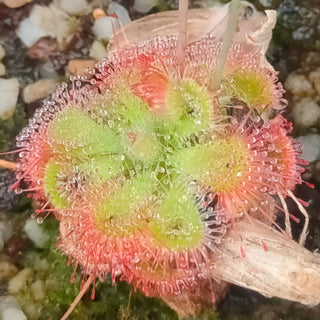Verbena stricta
HOARY VERVAIN
- Unit price
- / per
Verbena stricta, also known as hoary verbena or hoary vervain, is a small purple wildflower native to a large region of central Canada and the United States.
Because of its versatility and hardiness, it is mostly found in meadows, fields, and dry sandy soils. It is an extremely drought-resistant and nonaggressive species.
In ideal growing conditions it can grow up to 2-4 feet (0.6-1.2 m) with a spike of densely packed flowers.
The flowers can bloom in a variety of colors, the majority of them purple or a lavender shade, with rose pink or white rarely appearing.
Height: 2-4', 0.6-1.2m
Type: Hardy perennial
Hardiness zones: 3-7
Location: Sun
Sow just under the surface of the soil and water in. Leave them at room temperature for 6 weeks. This helps break the phytohormones which inhibit germination. They will not grow yet. Then a cooling period is required. Cover them with plastic and place in a fridge for 80 days. Be sure they stay moist. After the cold stratification period they are then brought back to a cool room (15-18C, 59-68F) for them to germinate. Germination can be erratic, generally 30-90 days after the warming period for most seeds, though some can take longer.
Verbena stricta
HOARY VERVAIN
- Unit price
- / per
Multiple secure payment options available.
Adding product to your cart
You may also like
Verbena stricta, also known as hoary verbena or hoary vervain, is a small purple wildflower native to a large region of central Canada and the United States.
Because of its versatility and hardiness, it is mostly found in meadows, fields, and dry sandy soils. It is an extremely drought-resistant and nonaggressive species.
In ideal growing conditions it can grow up to 2-4 feet (0.6-1.2 m) with a spike of densely packed flowers.
The flowers can bloom in a variety of colors, the majority of them purple or a lavender shade, with rose pink or white rarely appearing.
Height: 2-4', 0.6-1.2m
Type: Hardy perennial
Hardiness zones: 3-7
Location: Sun
Sow just under the surface of the soil and water in. Leave them at room temperature for 6 weeks. This helps break the phytohormones which inhibit germination. They will not grow yet. Then a cooling period is required. Cover them with plastic and place in a fridge for 80 days. Be sure they stay moist. After the cold stratification period they are then brought back to a cool room (15-18C, 59-68F) for them to germinate. Germination can be erratic, generally 30-90 days after the warming period for most seeds, though some can take longer.

















































